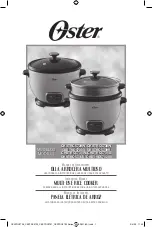
12
The air inside the oven is heated by the element around
the fan situated behind the back panel. The fan circulates
hot air to maintain an even temperature inside the oven.
The advantages of cooking with this function are:
l
Faster Preheating
As the fan oven quickly reaches temperature, it is not
usually necessary to preheat the oven although you
may find that you need to allow an extra 5-7 minutes
on cooking times. For recipes which require higher
temperatures, best results are achieved if the oven
is preheated first, e.g. bread, pastries, scones,
souffles, etc.
l
Lower Temperatures
Fan oven cooking generally requires lower
temperatures than conventional cooking.
Follow the temperatures recommended in the
cooking chart. Remember to reduce temperatures by
about 20-25°C for your own recipes which use
conventional cooking.
l
Even Heating for Baking
The fan oven has uniform heating on all shelf
positions. This means that batches of the same food
can be cooked in the oven at the same time.
However, the top shelf may brown slightly quicker
than the lower one.
This is quite usual. There is no mixing of flavours
between dishes.
How to Use the Fan Oven
1. Turn the oven function control knob to
.
2. Turn the thermostat control to the required tempera-
ture.
THINGS TO NOTE
l
The oven light will come on when the oven function
control knob is set.
l
The thermostat control light will remain on until the
correct temperature is reached. It will then cycle on
and off to show that temperature is being
maintained.
Hints and Tips
- Shelf positions are not critical, but make sure the
shelves are evenly spaced.
- When cooking more than one dish in the fan oven,
place dishes centrally on the shelves rather than
several dishes on one shelf.
- When the oven is full, you may need to allow slightly
longer cooking time.
- When the oven is full of the same food, e.g. equal
trays of small cakes or equal size victoria sandwich
cakes, then they will be cooked in the same time
and removed from the oven together. When different
sizes of trays or types of food, e.g. biscuits and cakes
are cooked, they will not necessarily be ready
together.
F
The Fan Oven
Food
Shelf
Cooking
Position
Temp (°C)
Biscuits
180 - 190
Bread
210 - 220
Casseroles
130 - 140
Cakes:
- Small and queen
160-170
- Sponges
160 - 170
- Madeira
140 - 150
- Rich Fruit
130 - 140
- Christmas
130 - 140
- Meringues
90 - 100
Fish
170 - 190
Fruit Pies and Crumbles
190 - 200
Milk Puddings
130 - 140
Pastry:
- Choux
- Shortcrust
- Flaky
190 - 200
- Puff
Plate Tarts
180
Quiches/Flans
170 - 180
Scones
210 - 220
Roasting:
Meat & Poultry
160 - 180
}
This chart is intended as a guide only. It may be
necessary to increase or decrease the temperature to
suit your individual requirements. Only experience will
enable you to determine the correct setting for your
personal requirements.
Fan Cooking Chart
- The fan oven can be used to heat foods through without
thawing first, e.g. fruit tarts, mince pies, sausage rolls,
and other small pastry items. Use a temperature of
190-200°C and allow 20-40 minutes (depending on
the quantity of food in the oven).
- The use of too high temperatures can cause uneven
browning. Check with the recommendations for oven
temperatures given in the cooking charts, but be
prepared to adjust the temperature, if necessary.
Remember to reduce temperatures by about 20-25°C
for your own conventional recipes.
- When roasting do use the trivet in the meat tin. Fat
and meat juices will drain into the meat tin below and
can be used to make gravy. The trivet also prevents
splashes of fat from soiling the oven interior.
- The meat tin
should not
be placed on a heated
hotplate as this may cause the enamel to crack.
Shelf positions
are not critical
but ensure that
oven shelves
are evenly
spaced when
more than one
is used.










































